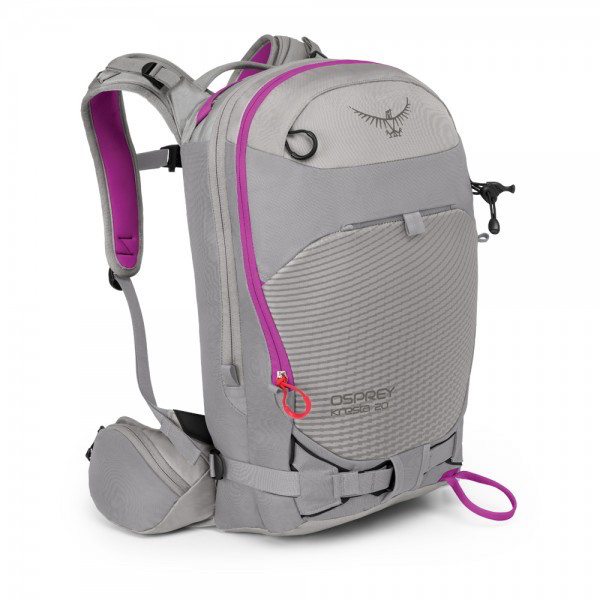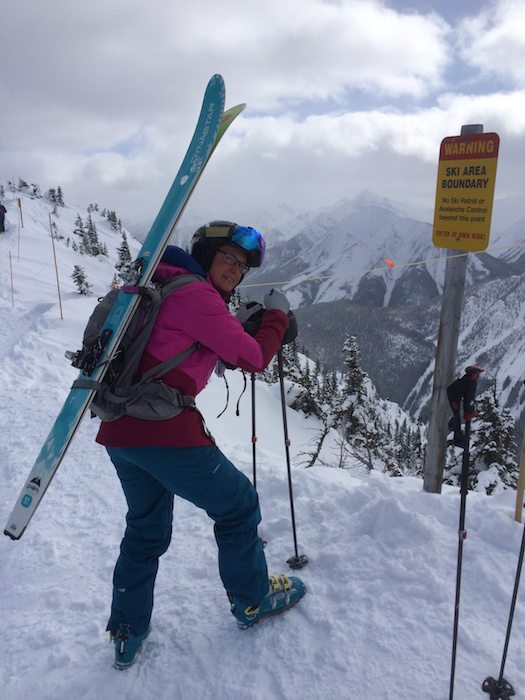My new husband (!) and I tested the Osprey Kamber (for men) and Kresta (Osprey’s first female-specific ski pack) rucksacks during our recent ski trip to Canada. We visited Alberta and British Columbia an used the 22l and 20l packs, respectively, every day for general ski resort skiing. We carried items such as spare layers, water, ski goggle lenses, water and snacks.
We also utilised the ski packs to carry our skis when boot-packing to off-piste areas, and also for stowing snow shovels and probes for back country skiing.
There are other size versions of the packs including a 30l for women and a 32l and 42l for men.
Like most Osprey packs, there are many features for the Kresta and Kamber.
Features include:
- Compression moulded back panel with snow-shedding properties
- Abrasion resistant PU texture on front panel of pack
- Integrated ski/climbing helmet storage and helmet chin-strap attachment loop (I told you Osprey think of every small detail!)
- Insulated shoulder harness hydration sleeve
- Internal hydration sleeve
- Diagonal/back ski carry
- Vertical and horizontal back panel snowboard carry
- Adjustable ski/snowboard lasso carry strap
- Quick access avalanche safety kit pocket with shovel handle and probe sleeves
- Glove friendly buckles
- Internal key attachment clip
- Internal wet/dry compartment
- Main compartment with elasticated load control system
- Microfleece goggle pocket
- Sternum strap with emergency whistle
- Stowable single ice axe loop
- Two zipped hip belt pockets.
A few features in photos
On test: Osprey Kresta and Kamber packs
Both packs were a good fit for us. The female version is slimmer and slightly smaller and I welcomed that because men’s packs are usually too big for me.
The packs are taller and slimmer to make them flatter against the back. This is really useful when back country skiing and boot packing because a bulky pack is a liability when skiing through trees and close to rocks. We also found the flatter style of pack worked well on ski chairlifts. They allowed you to sit back comfortably and not feel as though you were about to slide off the front of the chairlift due to a bulky pack. (Some chairlifts require you to take off your packs but not all.)
The shoulder straps are wide rather than very cushioned and this makes them light and comfortable. I did find it quite hard to get the second shoulder strap over my arm and shoulder at first.
I think that it was because of the shape of the shoulder straps, or the durable but stiffer edges, they got caught on the sleeves of my ski jacket.
It was really frustrating in the first few days of wearing the pack and I had to get G to unravel the twisted shoulder strap each time I put it in but then, suddenly, all was well again and the pack went on just like any other. It was possibly due to my bulky clothing layers or simply that the pack softened a bit.
Strangely, G had no such issues with his pack.
Once on, the straps including shoulder, waist and sternum are easy to adjust and allow for a good fit.
The back of the pack is stiff but padded. Like a hard foam. I found this really comfortable. It was also useful as light back protection when I fell while skiing.
Both of us remarked on how easy it is to wear the packs while skiing. They fit neatly and comfortably and at times I forgot I had a pack on.
There are two main compartments. The pocket closest to the back is for a hydration bladder and anything light and flat that you might want to carry. For example, spare base layers. I found it easily housed a 15-in MacBook while travelling to our destination. (We used the packs for hand luggage.)
The hydration bladder feeds water through a tube that is housed in a zipped pocket on the shoulder strap. This is a new innovation and really clever. How many times have you gone to take a drink only to find the tube is frozen? When skiing this is a major problem but Osprey has come up with a solution by covering the tube by a pocket.
It is a bit of a faff to get the tube inside the pocket in the first place and when you want to take a drink you need to do a bit of fiddly unzipping but it does keep the water flowing and this is essential when skiing or ski touring.
There is also a small mesh zipped pocket in this compartment.
The other larger main pocket has more space for kit and in-built vertical sleeves for neatly carrying avalanche kit. There is a sleeve for a shovel handle and a probe. This would make it quick and easy to reach for these items if you needed to use them.
There is another zipped mesh pocket in this compartment.
The main zip on this larger compartment has three zip pulls so it can be opened from any side for speed and convenience. Even better, one pull is red so you know you’re in the right compartment in an emergency.
It’s good to see that the pulls are large and very easy to use even with gloves. (I hate fiddly zip pulls so Osprey score full points here.)
It is easy to carry skis on the pack. The straps are found tucked neatly away in small Velcro pockets. We loved that the straps can be put away when not in use and brought out when you need them.
G says: “A pet hate of mine is loose and flappy straps on rucksacks but Osprey seem to have sorted this and have kept straps to a minimum and where there are straps that are occasionally used you can tuck them away very neatly.
“It’s the same with the helmet carrier. That tucks away into a small pocket when not in use. It’s great because one complaint I have had of Osprey before is all the straps everywhere.”
Larger packs in this series allow you to carry the skis on the side of the pack to form an A shape but the smaller packs have a system where you carry the skis in a diagonal vertical order.
We were a bit doubtful about this arrangement but it is actually brilliant. Because the pack can be comfortably adjusted to fit neatly against the body, the skis do not bang around and the felt surprisingly ok attached to the pack.
G says: “I found it a quick and easy way to attach skis to my pack. The weight felt evenly distributed and there was no pulling back or irritations. I hardly noticed I was carrying them.
“The skis sit high enough so they do not bang the back of your legs and at an angle so you do not hit your head off them higher up. I am really impressed with the system after using an A frame style in other packs.”
There are alternative straps for carrying a snow board horizontally.
I also found the top straps for carrying the skis very useful on our wedding day. I secured my bouquet to the pack with the strap and carried it around while skiing, much to the amusement of other skiers. (I had paid quite a lot for the bouquet and wanted to enjoy its benefits far longer than our sort wedding ceremony on the mountain slopes.)
The waist strap has excellent and has large zipped hip pockets. These are really useful for carrying small bits and pieces that you want easy access to. The waist straps also adjust very easily by tugging them inwards to give a neat fit and to allow for the weight of the pack to be carried higher up your back rather than hanging low.
The pack is very good quality, just like I would expect from Osprey. The fabrics look like they are built to last and the addition of a toughened fabric at the back of the pack is a very good idea. This means that the carriage of skis will not unduly damage the fabric of the pack.
Other nice extra features include the ice axe loop, which is also tucked away behind Velcro to use when you need it.
In fact, the rucksack looks very neat and smooth when everything is tucked away and this is great for back country skiing etc where you often encounter low hanging trees or rocks. If you had straps, or a helmet cover, flapping about they might be liable to snag on overhanging objects.
The soft-lined goggle pocket is brilliant for stowing spare lenses etc.
There is a whistle on the sternum strap. I think this should be bigger and more easily accessible. To use it you need to undo the sternum strap and then find the small whistle aperture. The time when you would most need this whistle when back country skiing, especially overseas, is for tree wells.
Tree wells are where snow builds up very deeply but softly around a tree and if you fall into this while skiing you may need to be rescued. The wells are deep and surrounded by hard packed snow so people can become trapped.
The whistle could be your only way of alerting others to your emergency. Many skiers in Canada carried a big whistle on their ski jacket and I think you would need this as an emergency back up rather than relying on the Osprey whistle. It’s simply too small and not very loud.
The only other point is that if you were embarking on a bigger expedition you would need to buy a larger pack. The smaller Osprey Kresta and Kamber packs were fine for day skiing and short back country outings close to resorts but they would not be large enough for all your kit if you planned to take on a larger or more arduous expedition. I guess that is why Osprey have designed the packs in different sizes!
Overall we would both rate these packs very highly. See Kresta 20 and Kamber 22. Prices start at £120.












